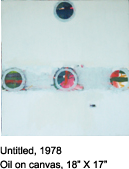
To put first things first, it should be stated that these are beautiful paintings. They are fresh, interesting, and almost hopelessly optimistic. They must be easy to live with. Lightness of touch, spaciousness, and impeccable color harmonies give these paintings the quality of music--of Mozart.
Ethe seems to be working from a creative consciousness close in texture to the Zen mind. Endless curiosity about surface and depth relations make these metaphysical paintings. They ask us to be simpler, lighter; and they are persuasive.
Author,
“The Spiritual in Twentieth Century Art”
Mr. Ethe’s paintings are worth catching for their astute management of a repeated motif: a translucent ground of the palest blue, through which chromatic adventures of one kind or another are trying to force their way.
The New York Times
Ethe’s painting harks back to an older idea of the purpose of modern abstract art. Early pioneers such as Piet Mondrian, Wassily Kandinsky and Franz Kupka used abstract form as a vehicle to convey a metaphysical content. The spiritual was evoked as the justification and rationale for art without subject matter. Ethe’s approach to color and design recalls the posture of the originators of abstract art rather than the critical orientation of his peers.
Ethe’s youthful colors seem like expressions of hope and happiness: the hope of an artist to create a world of happiness through his art.
The artist has brought each individual painting to completion by a spontaneous and free-form interaction with the work in progress. Ethe has employed this creative methodology because he felt it was the best way to “keep the tip of the tree the greenest.” His paintings are lush, fluid, richly emotional, and deeply sensual statements about the evocative power of color.
ARTS Magazine
Solomon Ethe creates quiet paintings with much force. Ethe hints at the relationship of mathematics and astronomy, and his space voyages are reminiscent of Paul Klee’s sea chartings. Through the exploration of color and surface he expresses his own sensibility.
Artspeak
